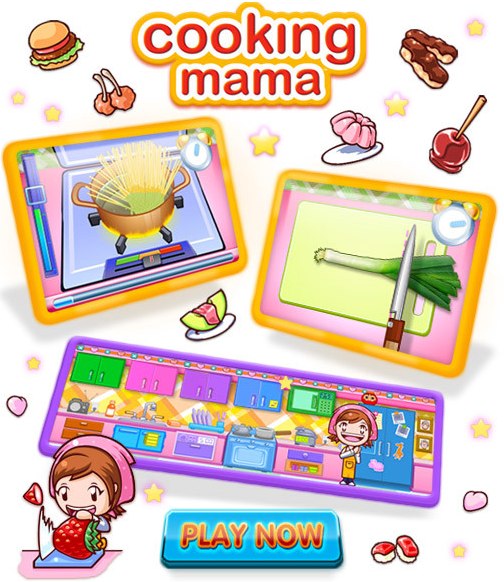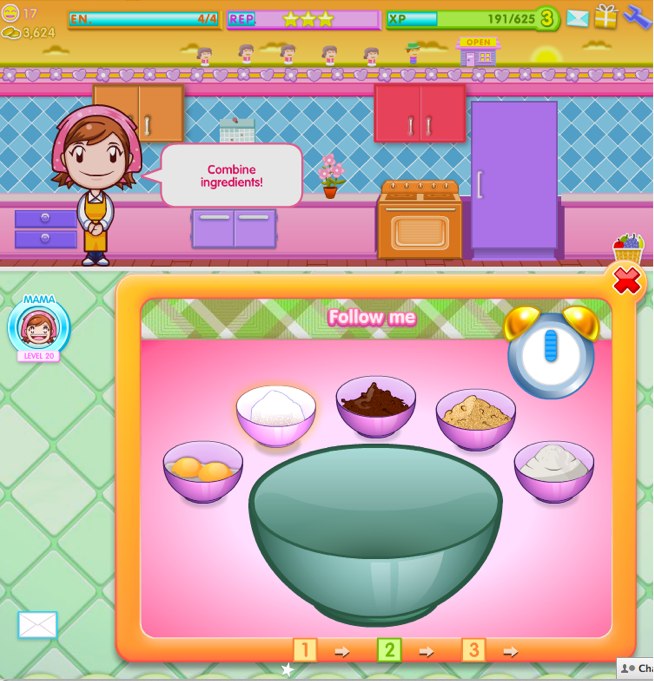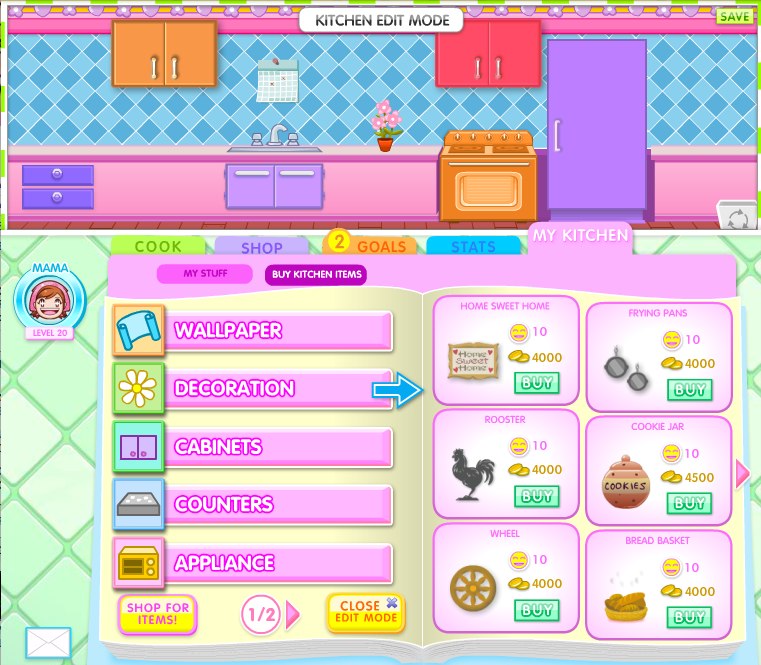热门料理游戏《料理妈妈》登陆Facebook社交网站
随着各形各色的游戏纷纷进军Facebook社交网站,最近任天堂DS游戏《料理妈妈(Cooking Mama)》也将搬上Facebook平台。
然而,据游戏邦了解新款Facebook版《料理妈妈》将加入更多的迷你游戏机制,以深化游戏体验。在Facebook版《料理妈妈》中,玩家不仅要在各个迷你游戏环节完成料理制作,同时还要兼顾不同顾客的各种要求。
以下游戏邦为您简单介绍Facebook版烹饪游戏《料理妈妈》。
《料理妈妈》围绕将食材烹制称菜肴为主题,其中的菜肴烹制过程以迷你游戏的形式出现。以黄油吐司为例,玩家仅需在烤熟的面包上涂上黄油(点击鼠标,拖曳涂满整片吐司)便可完成料理。而烤芝士三明治则比较复杂:首先玩家要将整块芝士切成薄片,然后通过前后拖曳鼠标将三明治在平底锅上烤熟,之后上拉鼠标以翻转三明治。完成每个烹调步骤后,游戏系统会根据完成程度进行评分,每个步骤的得分将影响该款料理的最终得分。玩家通过迷你游戏完成某款料理后,便可以在餐厅中选择提供该款菜品。
另外,Facebook版《料理妈妈》融入了一定的时间元素,玩家可以自行选择上次耗费的时间。但当然,上菜的速度越快,菜色质量就会有所下降,而同时失败率也会提高。一旦失败,玩家不仅需要延长上菜时间,期间盈利也会有所下降;而如果放慢上菜速度,虽然“安全性”有所保证,但直接结果就是盈利较低。
等级提升后,玩家可以在餐厅菜单中添加更多的高收益,高经验值菜肴。经营餐厅的收入既可以购买更多的食材,也可用于购买各种厨房装饰品,如橱柜,面包篮,平底锅等。
据游戏邦了解,Facebook版《料理妈妈》也发布了游戏任务机制,如限时内提供一定数量的某款料理或为厨房增加装饰等。完成任务后便可以获得游戏币和经验值奖励。新菜式要通过玩家提升等级来解锁。每款菜都有自己的经验条,玩家不断重复制作某一料理便可升级该菜式。
但是,玩家不可能没有极限地不断制作料理。Facebook版《料理妈妈》引入了“能量”机制。制作料理必然将消耗玩家的能量。在初始阶段,能量基本属于“用不完”。随着玩家的等级越高,菜式越复杂,玩家的能量也就消耗得越快。
从技术角度上看,由NDS移植的Facebook游戏《料理妈妈》在人物形象,游戏画面方面并不十分卓越,然而其提供的游戏乐趣吸引了无数众多掌机玩家的热烈追捧。最后,游戏邦衷心期望Facebook版《料理妈妈》能在社交网站平台上再创佳绩。(本文为游戏邦/gamerboom.com编译,转载请注明来源:游戏邦)
I’m about to have a bit of a fan girl fit here (forgive me), but one of my favorite Nintendo DS game series is now available to play on Facebook. Arkadium, Majesco, and Cooking Mama Ltd have all partnered to bring Cooking Mama to Facebook as an in-depth experience, rather than just a standard mini-game title.
Sure, there are plenty of mini-games here to participate in, but the game is more complex than your standard handheld game. You won’t just be completing mini-games by cooking dishes for the sake of cooking dishes, as you’ll have customers that will order certain food dishes, and you’ll need to take care of their needs and desires.
Meet us behind the break for a look at how you can fulfill your customers’ orders, and how this online version of the game differs from those you’ve seen on other platforms.
For the overall scheme of gameplay, you’ll need to use ingredients to cook dishes. Cooking dishes is a mini-game situation, where you’ll find yourself spreading butter onto toast (click on the button and click and drag to spread it on the bread), chopping cheese or vegetables (click on the dotted line), and more. You’ll be scored at the end of each step, with some recipes requiring a number of steps to be completed, based on their complexity.
As our example with the Buttered Toast, this would only require one step, as the toast has already been cooked and all you have to do is spread the butter. For something like a Grilled Cheese Sandwich, however, you’ll first need to chop slices off of a block of cheese, and then physically grill the sandwich by moving your mouse back and forth to move the sandwich around the frying pan, and then flipping the sandwich over (so it doesn’t burn) by flicking your mouse upwards.
After each step, you’ll be scored on your accuracy (whether or not you burned the sandwich, to continue with our above example), and you’ll earn experience points at the end of the dish, based on your scores. Once you’ve cooked a dish through these mini-games, you’ll be able to serve them in your make-shift restaurant. In this comes the timed element to the game. You’ll be able to choose how long you’d like to serve a dish, based on how long you’d like to be away from the game. Since we’re talking about food, there is a “real-world” element in terms of spoilage, which makes the longer time frames worth less money (in the grand scheme of things), as the food would be of a lesser quality by the time the serving time frame ended. That is, you’ll earn more coins overall if you come back every half hour, rather than waiting a few hours, but of course, this isn’t realistic for the working individual.
As you level up, you’ll be able to add more and more dishes to your menu, to be served at once, resulting in more profits and experience points when you return after your shift is over. These profits can be used either to purchase more ingredients, allowing you to cook more dishes, or to purchase decorative items like more cabinets, bread baskets, hanging pans, etc. to your kitchen, which is viewed at the top of the screen.
There are also quests to complete in the game, like serving a particular dish for a specific amount of time, or even adding decorations to your kitchen. Completing quests earns you coins and experience points, with these coins being used to purchase the ingredients necessary to cook more dishes.
As if all of this didn’t give you enough to work on, as you level up, you’ll unlock new dishes, and you can then upgrade those dishes by cooking them subsequent times (using more ingredients to do so). Not only will you earn points overall for cooking dishes, but each dish itself has an experience point bar. Simply cook the dish repeatedly to fill the bar, and the dish will level up.
Unfortunately, you won’t be able to cook dishes indefinitely, as there is an Energy bar that uses up energy when you cook. For the first few levels, this isn’t really an issue, as you’ll level up quick enough to refill your energy bar during one sitting. However, in later levels, it might impact your progress while you wait for the bar to refill.
Technically, this is one of the cutest, most polished games we’ve seen, taking its graphical theme straight from the Nintendo DS game that started it all – meaning that you’ll see more bright or pastel colors and shiny stars and glitter animations in the game than you can shake a stick at. Not the most masculine of themes, to be fair, but the gameplay is a solid transition, from what we can tell from our hands-on time with the game.
If you’ve liked the Cooking Mama games released on the Nintendo DS or Wii in the past, and want to continue the cooking fun on Facebook, the game is now open to play for everyone.(Source: Games.com)











































